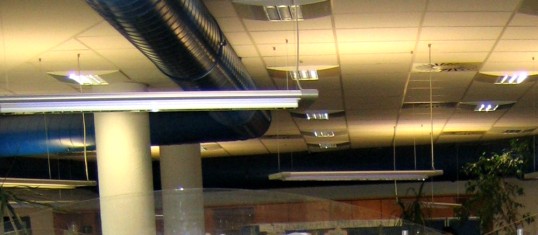- Elektromagnetic Fields
- Indoor workplaces
- Practical Solutions: Ergonomics
- Practical solutions: Hazardous substances
- Practical solutions: Noise
- Practical solutions: Machine safety
- Practical solutions: Personal Protective Equipment
Office lighting

Ceiling lamp and ceiling spotlights
Source: IFA
Lighting quality affects humans in two ways. Firstly, it influences vision, determining how quickly and precisely a person can discern detail, colour and shape. And secondly, it can boost or reduce activity and performance levels. Poor lighting can cause visual strain, leading to headaches, watery or stinging eyes or spots before the eyes.
Daylight plays an important role in indoor lighting. An adequate supply of daylight, combined with as little obstruction of the outside view (undistorted and unaltered) as possible, has a positive impact on employees' sense of wellbeing and thus on morale and productivity.
Daylight alone is not enough to ensure good quality lighting (particularly adequate illumination) throughout the entire working day, whatever the season. This is true even if the workstations are positioned directly next to the window and make optimum use of the daylight. As a result, artificial lighting has to be used.
For download
